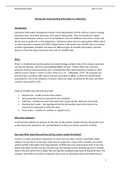Mohammed Salam Unit 4: LA D
Storing and communicating information in a laboratory
Introduction:
Laboratory Information Management System is the abbreviation of LIMS. LIMS are used to manage
laboratory data, streamline processes, and improve data quality. They are intended to replace
paper-based and legacy systems, such as spreadsheets, that are inefficient, inaccurate, unsafe, and
do not have an audit trail. In the assignment, I will discuss about the two organisations (Pfizer which
is a pharmaceutical company and NSCG College) where I will explain how scientific data is recorded
on both organisations, benefits, and issues for different types of scientific information I will also
discuss on how they input and extract from sets of scientific data.
Pfizer:
Pfizer is a multinational pharmaceutical and biotechnology company where the company produces
vaccines for diseases, and it has saved globally billions of lives. “Charles Pfizer was a German
American chemist and businessman who co-founded the Pfizer pharmaceutical company in 1849
with his cousin, Charles F. Erhart, as Chas. Pfizer & Co. Inc.” (Wikipedia, 2019). The company has
several drugs or products with annual revenues exceeding $1 billion. In 2020, the United States
accounted for 52% of the company's revenues, China and Japan accounted for 6% each, and other
countries accounted for 36%.
Types of scientific data that they deal with:
Clinical trials – health records of the patient
risk assessments that are associated in the workplace
Staff data – includes personal information like contact details, addresses and emails.
Chemical test results – the ingredients that the lab members put in the chemicals or
amounts of compounds to make the drug.
Tests results – weather it is positive or negative tests
Who is the customer?
Customers like patients are going to be the users of the product. People who buy the product such
as like pharmacist, physicians, G.P, and distributors as these are all also customers of Pfizer.
How does Pfizer input data and how do they extract useful information?
A LIMS is a system that allows laboratories to enter and save data; a LIMS is essentially a filing
cabinet, but one that is on the web rather than in a paper file. Using a LIMS, scientists can extract
useful scientific information from huge datasets. At Pfizer they may need to keep track of not only
health and safety records, but also scientific data and training records. Keeping big sets of scientific
data on the web rather than in paper files can help the workplace keep track of important data. The
company uses LIMS to provide its employees with access to documents they need rather than to
1
, Mohammed Salam Unit 4: LA D
have to search through a myriad of files to find the documents that they will as this can be time
consuming. Also, LIMS makes it easier for the company to obtain licenses and certificates and
provide proof of those documents to clients and potential clients.
To extract the useful information in Pfizer, the lab members can use the search functions to search
up the exact materials that they need through the use in LIMS system. The LIMS system can
generate barcodes when the initial sample data has been recorded so that it can be scanned again
by many of lab members, this can help the other lab members to update the data to its newest
version frequently.
Key information that is required to be recorded at Pfizer:
Medical history
Patient’s blood type
Risk assessments
Test results – like drug tests to see if they are effective to the patients and also any side
effects from the patients when using the drugs.
Test sample ID numbers – easier to search up the Test sample by searching up the id number
of the Test sample.
Chemical test sampling – checking the ingredients of the pharmaceutical drug.
Chemical and equipment stock – this is recorded as it can help to find out How much there is
left before they can get more.
How do they record the information?
To identify the causes of specific diseases, Pfizer can examine genomic sequencing data, medical
sensor data where it measures the patient's physical changes during the treatment, and electronic
medical records.
At Pfizer, they would record the information in the LIMS system Which are then put into the Pfizer
database like intranet or in cloud where it could necessarily be accessed by other lab members when
it is needed. Risk assessments are also alternative form of recording the information as it can able to
record any associated risks, hazards and mitigation in the workplace.
How does this ensure traceability?
At Pfizer, the lab member can spend less time ensuring all information is correctly logged and
organized when barcodes are scanned into LIMS. This ensures traceability: any lab member can
instantly recognize what the sample is and what tests it has undergone with a single barcode scan.
Each drug sample will have their own Sample ID number which is generally based on the date and
the time that it was booked in and will randomly make numbers at the end. Sampes can be barcoded
through a LIMS system when the lab members want to access the data, they can do this by scanning
the barcode of the sample to search up the data.
How does the customer meet the needs?
2




